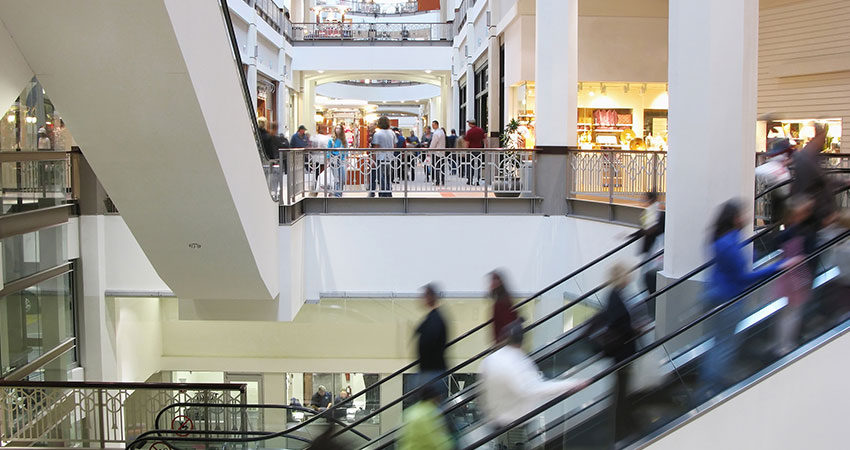In 2017, Credit Suisse projected that one in four U.S. malls would close by 2022.
Post-COVID, experts now see as many as one-third of malls closing over the next year. These are grim statistics indeed. But the pandemic might be the best worst thing to happen to the shopping center; it could actually force innovation onto what has, until now, been a change-averse business model.
This pandemic has pushed new digital habits onto even the last consumer adopters. The U.S. Census Bureau recently reported that ecommerce surpassed 44% of total retail sales in the second quarter of 2020, a number that’s double experts’ original projections (22% by 2023).
But brick and mortar is critical to making ecommerce profitable, and, as Target’s 10.9% increase in Q2 store comparable sales demonstrates, shoppers still visit stores. Large retailers such as Target and Walmart have figured out how to blend physical and digital to maximize profit through BOPIS, curbside and in-store same-day fulfillment — elements that are unattainable for smaller retailers.
Shopping malls are well-positioned to become that centralized operating system for smaller retailers to leverage these operational and financial gains. Creating a flexible range of services, spaces, leases and more will help malls regain community relevance and become profitable.
Flexible Retailing Is the Future for Shopping Malls
As big shopping mall owners such as Westfield and Simon have already realized, prioritizing ecommerce is the only way to connect with today’s customer journey. This involves making malls more vibrant and modern with a digital layer of experiences while still providing an atmosphere that can’t be replicated online. By integrating these types of flexibility into their operations, malls can work toward a more certain future.
Data Flexibility
Online shopping offers immediate access to a wealth of resources during the buying journey. Shoppers can instantly access YouTube tutorials, Yelp reviews, Instagram influencers, Amazon price comparisons and Google Shopping pages to learn almost anything about a potential purchase. Malls and retailers need to offer this same access to a customizable range of data throughout the on-site experience.
One example is Regent Street’s “mile of style” in London. Using iBeacons, sensors, geofencing and Bluetooth technologies, shoppers can use their smartphone to receive a personalized range of content through the Regent Street app to assist with navigation, boutique and restaurant information, reservations, discounts, event schedules and more.
Space Flexibility
Shoppers have adjusted to constantly changing trends and information thanks to almost real-time global social networks. In response, the needs of brick and mortar should easily morph in support.
Creating spaces and environmental elements that are flexible, modular and reconfigurable allows malls to adjust space needs or add rent streams from a wider array of new and existing tenants. This spatial flexibility also draws people who are excited to see whether that new product or service they saw on Instagram is as great in real life.
For example, Westfield San Francisco Centre developed a multipurpose space called “Bespoke” that can be reconfigured for co-working, events, product demos or pop-up retail. This space has quickly become a lucrative new revenue stream for Westfield that keeps shoppers returning often.
Flexible space is especially vital during COVID-19: Small stores, events and services need more room to permit social distancing. Being able to adjust space to allow existing tenants to periodically spread out can be a lifeline during unforeseen circumstances, both now and in the future.
Services Flexibility
Staying relevant to consumers means expanding not only the types of retail tenants accepted, but also services offered to the community. Moving away from the traditional “anchor tenant” mall structure is now imperative.
Apparel retail used to comprise as much as 60% of leasable square footage at a traditional mall. Today, that falls closer to 25% at successful properties. Miami’s Aventura Mall is one of these, offering visitors a world of services such as spas, medical offices and sports training centers. Permanent and temporary experiences and events such as Candytopia, art galleries, indoor ski slopes, drive-in movies, concerts and e-sports competitions are taking over its empty department store spaces.
For smaller retailers without the right square footage or location within the mall, shopping centers can consolidate popular retail services into a centralized, mall-run BOPIS area, a shared curbside drive-thru or a shared concierge service to add a menu of services that gives malls additional revenue streams.
Rent and KPI Flexibility
Along with creating flexible spaces, malls must develop a flexible lease model to allow them to attract direct-to-consumer temporary stores or pop-ups. Leases need to flex to expand or shrink space as businesses evolve or allow one retailer to spread products or services across multiple locations and formats for greater visibility.
In lieu of a straight footfall traffic formula to measure activity, the regional halo effect of brick and mortar on increased online sales should be taken into account. Sales per square foot must integrate online sales, as many online purchases happen after a shopper viewed an item in person but wouldn’t have purchased if she or he had not seen it in the store.
Flexibility across all aspects of shopping malls will allow this industry to regain health and thrive in the coming decades. In short, the mall of the future must reach back to its roots as a community centerpiece — but also flex to become an essential support system to help underdog retailers become profitable in the age of ecommerce.
DeAnn Campbell is the head of retail strategy and insights at Harbor Retail

